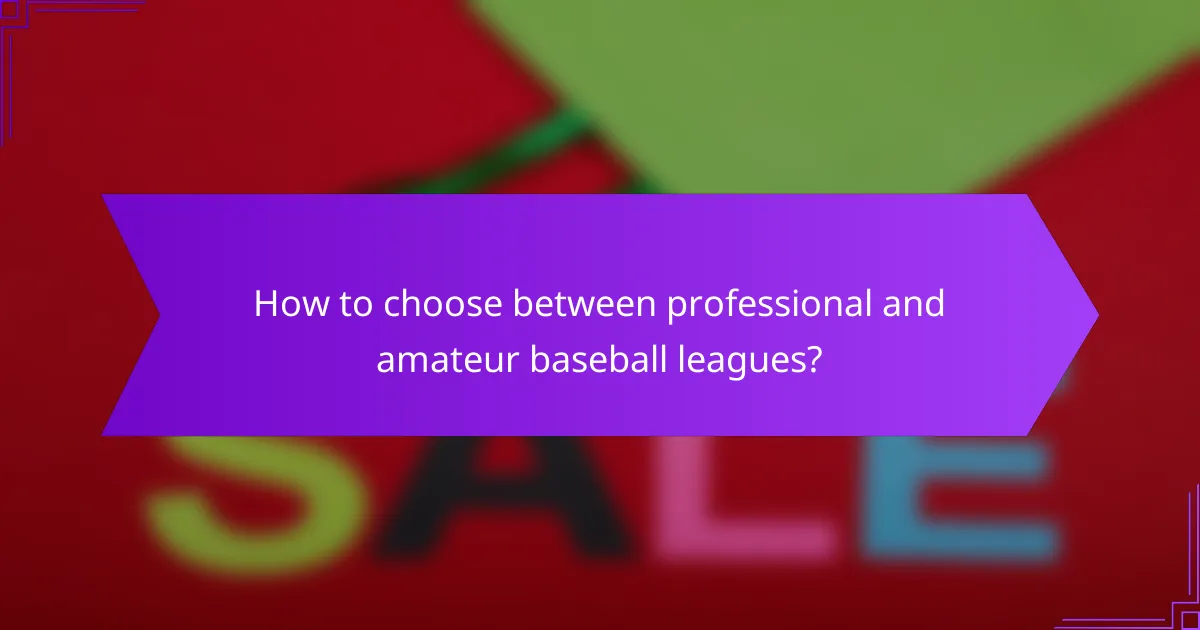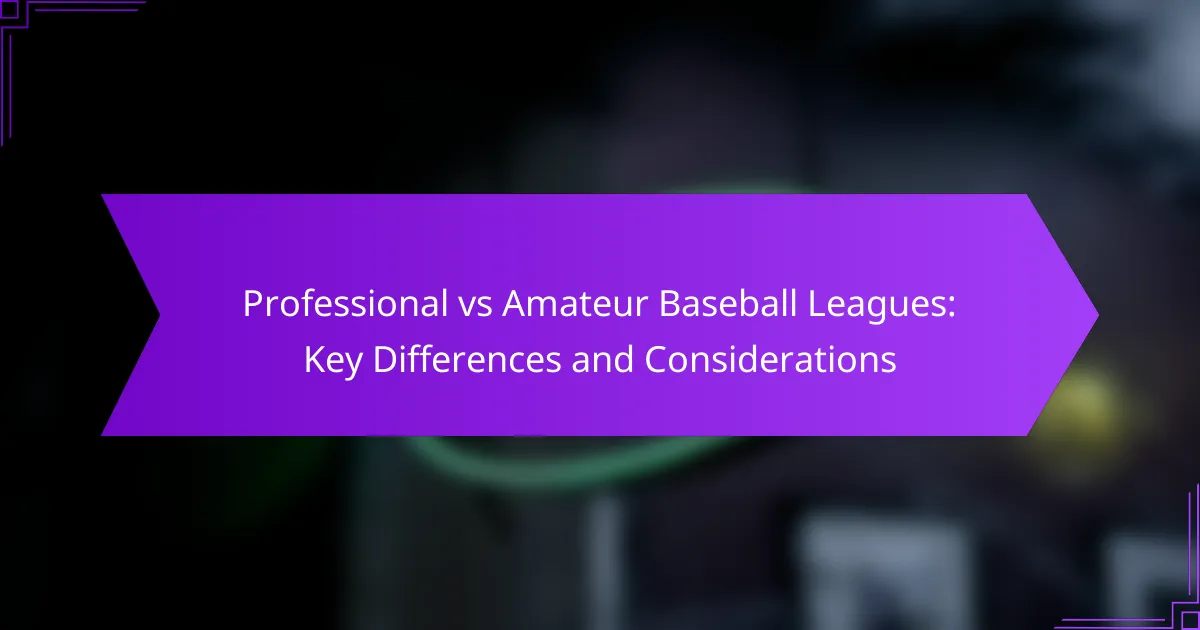Professional and amateur baseball leagues present distinct differences in player compensation, competition levels, and development opportunities. Understanding these variations is crucial for players and fans alike, as they influence career paths and experiences in the sport. Whether aiming for visibility and resources in a professional setting or seeking growth in an amateur environment, each league offers unique advantages and challenges.

What are the key differences between professional and amateur baseball leagues?
Professional and amateur baseball leagues differ primarily in player compensation, level of competition, regulatory oversight, fan engagement, and development pathways. Understanding these distinctions can help players, fans, and stakeholders navigate the baseball landscape effectively.
Player compensation and contracts
In professional baseball leagues, players are typically compensated with salaries that can range from thousands to millions of dollars annually, depending on their skill level and league stature. Contracts often include bonuses, endorsements, and benefits, making the financial stakes significantly higher than in amateur leagues.
Amateur leagues, on the other hand, usually do not provide financial compensation to players. Instead, participants may receive scholarships or stipends, particularly in college baseball. This lack of monetary incentive often leads to different motivations for participation, such as passion for the game or the pursuit of education.
Level of competition
The level of competition in professional leagues is generally much higher, featuring athletes who have honed their skills through years of training and experience. These leagues attract top talent, making the games more intense and strategically complex.
Amateur leagues vary widely in skill levels, from youth leagues to collegiate competitions. While some amateur leagues can be highly competitive, they often include players who are still developing their skills, leading to a broader range of performance levels.
Regulatory oversight
Professional baseball leagues are governed by strict regulations and oversight from organizations like Major League Baseball (MLB) in the United States. These regulations cover everything from player contracts to game rules, ensuring a standardized and fair playing environment.
Amateur leagues may have less formal oversight, with regulations varying by region and organization. For example, college baseball is regulated by the NCAA, which sets specific rules regarding player eligibility and scholarships, but local youth leagues might operate with minimal oversight.
Fan engagement and attendance
Professional baseball leagues typically enjoy higher attendance and fan engagement, with stadiums often filled to capacity during games. Marketing efforts, media coverage, and star players contribute to a vibrant fan culture that enhances the overall experience.
Amateur leagues may attract smaller crowds, although local support can be strong, especially for high school and college teams. Community involvement and family-oriented events often characterize amateur games, fostering a different kind of connection between players and fans.
Development pathways
Professional leagues offer structured development pathways, including minor leagues and farm systems, where players can refine their skills before reaching the major leagues. This system provides clear progression opportunities for aspiring athletes.
In contrast, amateur leagues often serve as the initial stepping stones for players, with many using college baseball as a way to showcase their talents to professional scouts. However, the pathways can be less defined, and not all players will transition to professional play, making it essential for athletes to explore multiple avenues for development.

How to choose between professional and amateur baseball leagues?
Choosing between professional and amateur baseball leagues depends on your goals, the league’s reputation, and financial considerations. Each option offers distinct experiences and opportunities that can significantly impact a player’s development and career trajectory.
Assessing player goals
Understanding your personal goals is crucial when choosing between professional and amateur leagues. If your aim is to pursue a career in baseball, a professional league may provide better exposure and competition. Conversely, if you prioritize enjoyment and skill development, an amateur league might be more suitable.
Consider what level of commitment you are willing to make. Professional leagues often demand rigorous training schedules and travel commitments, while amateur leagues may offer more flexibility for balancing other life responsibilities.
Evaluating league reputation
The reputation of a league can influence your visibility and opportunities for advancement. Research the history of the league, the quality of its teams, and the success of its players in moving to higher levels of competition. Professional leagues typically have established networks and connections to major leagues.
Engage with current and former players to gain insights into their experiences. This can provide valuable information about the league’s culture, competitiveness, and overall environment.
Considering financial implications
Financial considerations play a significant role in the decision-making process. Professional leagues may offer salaries, but they can also involve substantial costs for training, equipment, and travel. Amateur leagues often require lower fees, making them more accessible for players who may not want to invest heavily.
Evaluate potential earnings versus expenses in both types of leagues. For example, while professional players might earn thousands of dollars, they may also face costs that can offset their income. In contrast, amateur players might pay a few hundred dollars for participation but have fewer financial risks.

What are the benefits of joining a professional baseball league?
Joining a professional baseball league offers significant advantages, including increased visibility, access to superior training resources, and valuable networking opportunities. These benefits can enhance a player’s career prospects and overall development in the sport.
Higher visibility and exposure
Professional baseball leagues provide players with greater visibility, attracting scouts, agents, and fans. This exposure can lead to potential contract offers and sponsorship deals, significantly boosting a player’s career.
Players in these leagues often participate in televised games and high-profile tournaments, which can further enhance their public profile. This visibility is crucial for those aspiring to advance to higher levels of competition, such as Major League Baseball (MLB) in the United States.
Access to advanced training facilities
Professional leagues typically offer access to state-of-the-art training facilities, including gyms, practice fields, and specialized coaching. These resources are designed to help players refine their skills and improve their performance.
Training facilities often include advanced technology for performance analysis, which can provide insights into a player’s strengths and weaknesses. This access enables players to develop more effectively than in amateur leagues, where such resources may be limited.
Networking opportunities
Joining a professional league opens doors to valuable networking opportunities with coaches, former players, and industry professionals. Building relationships within this network can lead to mentorship, advice, and potential career advancements.
Players can connect with agents and scouts who can facilitate moves to higher leagues or international opportunities. Engaging with a professional community can also provide insights into the business side of baseball, including contract negotiations and endorsements.

What are the benefits of joining an amateur baseball league?
Joining an amateur baseball league offers numerous advantages, including lower commitment levels, opportunities for community engagement, and cost-effectiveness. These benefits make amateur leagues an appealing choice for players of all ages and skill levels.
Lower commitment levels
Amateur baseball leagues typically require less time and effort compared to professional leagues. Players often have flexible schedules, allowing them to balance baseball with work, school, or family commitments. This lower commitment level makes it easier for individuals to participate without feeling overwhelmed.
For instance, many amateur leagues hold games on weekends or evenings, which can accommodate various lifestyles. This flexibility can be particularly beneficial for those who want to enjoy the sport without the pressure of a demanding schedule.
Community engagement
Participating in an amateur baseball league fosters a sense of community and belonging. Players often form strong bonds with teammates and local fans, creating a supportive environment that enhances the overall experience. This engagement can lead to lasting friendships and a deeper connection to the local area.
Many amateur leagues also involve community events, such as fundraisers or family days, which further strengthen local ties. These activities not only promote the sport but also encourage community members to come together and support one another.
Cost-effectiveness
Amateur baseball leagues are generally more affordable than professional leagues, making them accessible to a wider range of players. Registration fees, equipment costs, and travel expenses are typically lower, allowing individuals to participate without significant financial strain.
For example, many amateur leagues charge modest fees that cover uniforms and field rentals, often totaling a few hundred dollars per season. This cost-effectiveness enables families to enroll their children in baseball without breaking the bank, promoting youth participation in sports.

What are the common challenges faced in professional baseball leagues?
Professional baseball leagues encounter a variety of challenges that can impact teams, players, and overall league operations. These challenges include financial pressures, player injuries, and maintaining competitive balance among teams.
Financial Pressures
Financial pressures are a significant challenge in professional baseball leagues. Teams must manage expenses related to player salaries, stadium maintenance, and operational costs while also striving to generate revenue through ticket sales, merchandise, and broadcasting rights.
For instance, teams in larger markets may have more financial resources compared to those in smaller markets, leading to disparities in player acquisition and retention. This can create a competitive imbalance, making it difficult for lower-budget teams to compete effectively.
Player Injuries
Player injuries pose a constant challenge in professional baseball. The physical demands of the sport can lead to various injuries, which not only affect individual players but also impact team performance and strategy.
Teams must invest in medical staff and rehabilitation programs to manage injuries effectively. Additionally, the risk of injuries can influence decisions regarding player contracts and roster management, as teams weigh the potential return on investment for injured players.
Maintaining Competitive Balance
Maintaining competitive balance is crucial for the success of professional baseball leagues. Unequal talent distribution can lead to uncompetitive seasons, diminishing fan interest and engagement.
Leagues often implement measures such as salary caps, revenue sharing, and draft systems to promote parity among teams. These strategies aim to level the playing field, allowing teams with fewer resources to compete more effectively against wealthier franchises.



